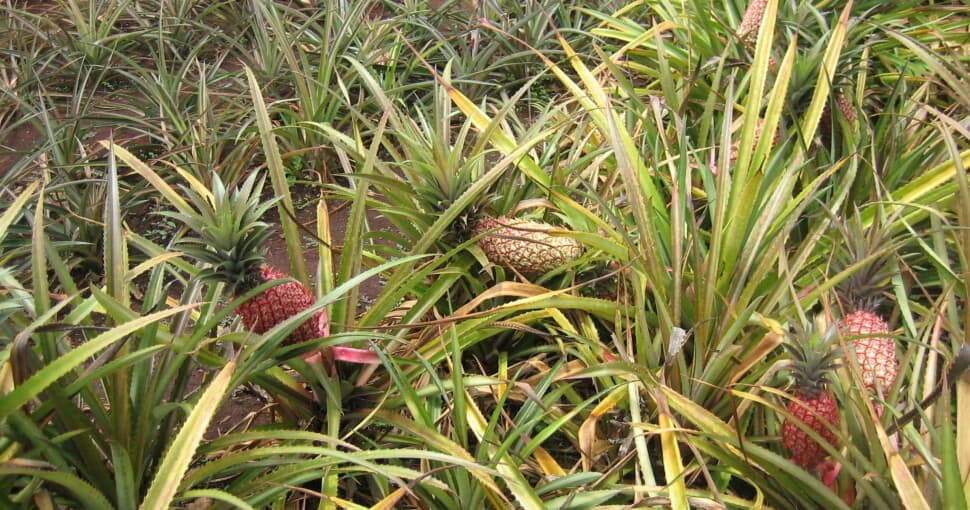The pineapple (Ananas comosus) is the edible variety of pineapple and has five botanical varieties. Each produces slightly different characteristics, producing thirty-seven pineapples grown commercially worldwide. Of course, these numbers only account for the edible pineapple varieties. The Ananas genus is part of the Bromeliaceae family of plants that encompasses a massive three thousand species.
Contents
Pineapples are native to South America but have spread to all tropical climates because of their delicious fruit and ease of growth. It was even a status symbol in Europe as far back as 1650. Pineapples were costly to transport to Europe via boat. Greenhouses built for growing pineapples were even more costly. Thus, having a pineapple symbolized wealth and status.
Today pineapples have become far more common. The fascination of growing them for their delicious fruit or because of the striking plants has remained. Today it is far easier to grow pineapple plants or plants that look like pineapples than in the seventeenth century, and not nearly as costly.
The good news about Bromeliads being such a large family is that there is a plant that will suit everyone somewhere in this big, happy plant family. Here are some options to choose from.
Related: 7 Plants That Look Like Pineapples
1. Spider Plant
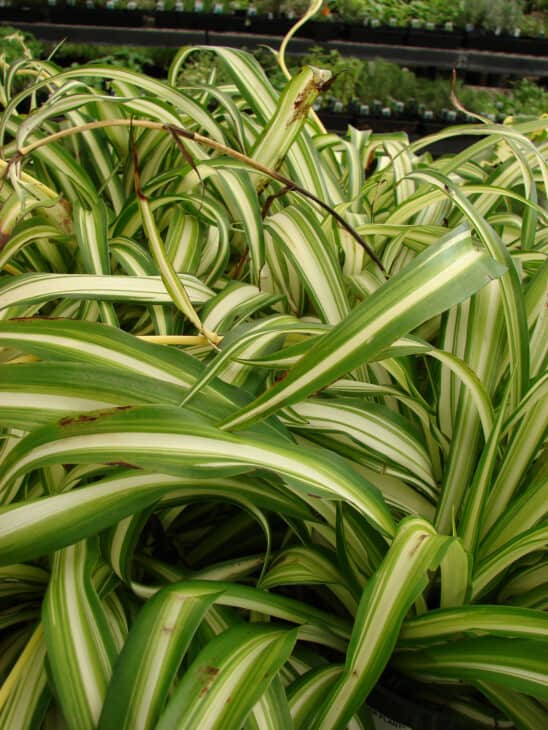
The spider plant (Chlorophytum comosum) may also go by names like spider ivy, ribbon plant, and hen and chicks. Spider plants are native plants from Southern Africa, but they have spread worldwide due to their ease of growing. They prefer to grow in a tropical environment but are highly adaptable as houseplants.
The leaves of spider plants are smoother than pineapple plants, and the edges lack rough serrated edges. The leaves grow from a central point in a similar pattern to the pineapple plant. The leaf length of spider plants ranges between eight and eighteen inches. Spider plants can be light green or variegated in color. The cream and green variegated varieties are the more popular of the two.
Plantlets form on the ends of the flower stem. As these plantlets grow and get too heavy for the plant to keep upright, the flower stem drops onto the soil and produces a new baby plant. This characteristic is what gave rise to the name hen and chicks.
Related: 8 Plants That Look Like Spider Plants | 8 Spider Plant Benefits
2. Thatch Screwpine
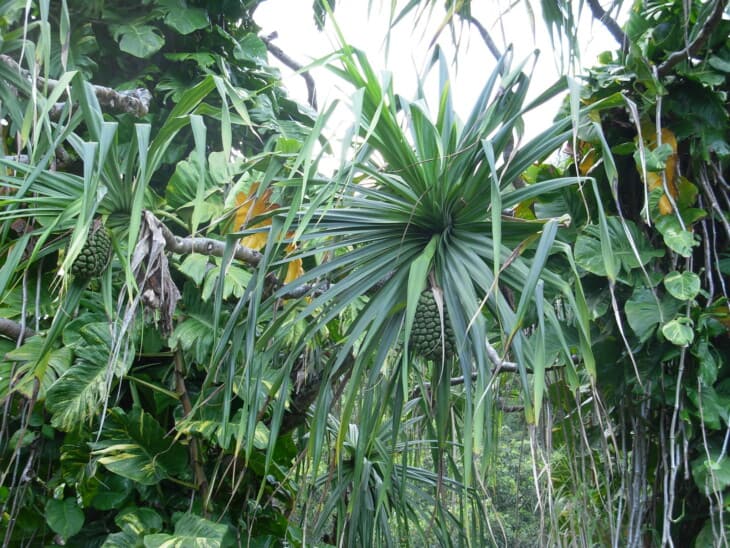
The Thatch Screwpine tree (Pandanus tectorius) goes by names like tourists’ pineapple and Hala tree. Thatch screwpine is native to Malesia, Australia, and the Pacific regions. It grows well in coastal and tropical areas, and this tree has become a beautiful addition to gardens in warmer climates outside its native regions.
Female thatch screwpine trees bear a fruit that very closely resembles a pineapple. In Hawaii, this gave rise to the name tourist’s pineapple. This fruit has many keys or discs, with a juicy but fibrous pulp that can be chewed on. The hard seeds inside these keys are also edible once fully ripe but are hard to crack. Those in the know say the seeds taste like a combination of coconut and peanuts.
Screwpines grow as small trees with palm-like leaves. The leaves are much more flexible than those of a pineapple. These leaves are used to weave many functional items ranging from trinkets like jeweler boxes to mats and thatched roofs, where one of its names was derived.
3. Pineapple Lily
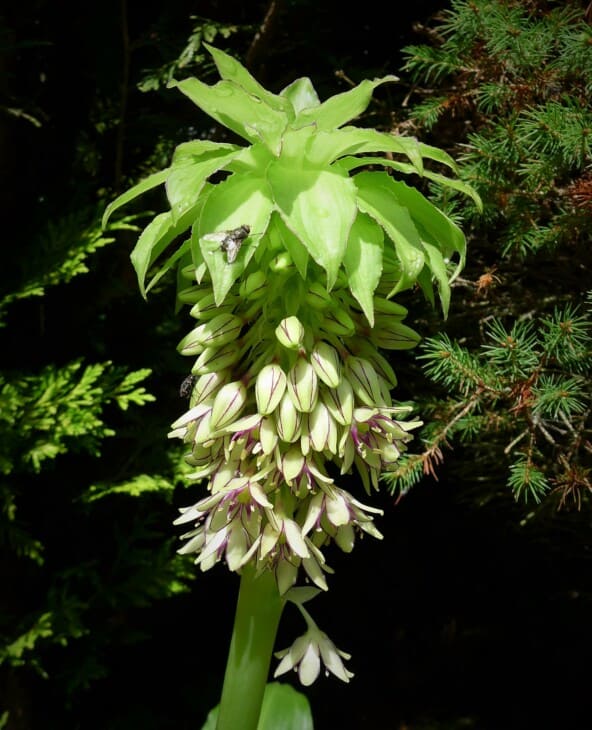
The pineapple lily (Eucomis comosa) or pineapple flower is a perennial plant grown from a bulb. Despite the name, pineapple lilies are not pineapples. The flowers grow in a shape that resembles a pineapple, resulting in the descriptive name. Pineapple lilies are part of the asparagus family, and this perennial is endemic to South Africa.
The flowers are arranged densely on a spike and range from white to pale purple. Once the colored petals fall off and the fruits start to mature, the spike that terminates in a rosette of leaves looks like a pineapple fruit.
With enough light, pineapple lilies grow well indoors as a container plant. As the plant matures, it produces additional bulbs that require dividing every few years. This makes for a beautiful and unusual indoor plant with large light green leaves arranged in a rosette before the flower spike appears.
4. Aechmea Bromeliad
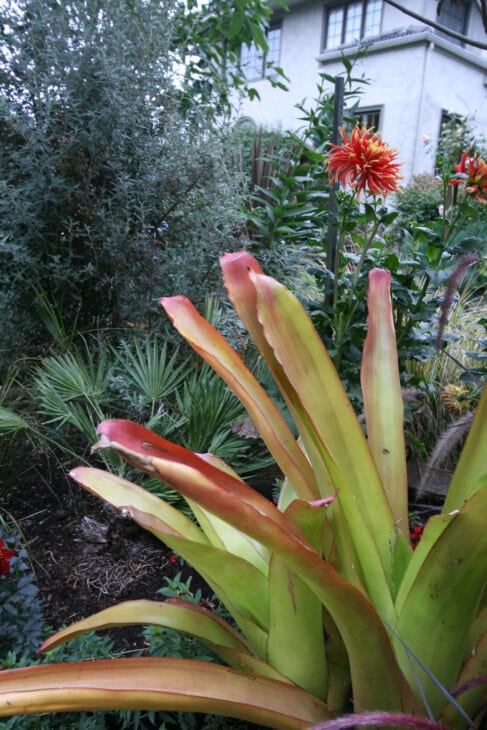
Aechmea bromeliads are members of the flowering subfamily Bromelioideae, with more than two hundred species recorded in the Aechmea genus. What all the Aechmea plants have in common is their simplistic beauty. Their name means spear, which describes their leaves well.
Aechmea leaves vary in color from bright green to blue-green and often look like they have a powder dusting. The leaves grow from a central point in a rosette pattern and curve backward with strongly serrated edges. Aechmea produces a single flower during the lifespan of the plant. Usually pink in color, the plant forms from a single spiky flower that could last for months.
Most Bromeliads are epiphytes that thrive in a tropical environment. This makes them quite easy to grow as the soil is not needed for nutrition but rather to anchor the plant. Aechmeas draw food and moisture from their environment but occasionally require watering via the central cup of leaves to stay healthy. The aechmea will start to die after flowering but not before forming a new plantlet that will replace it.
5. Dwarf Pineapple
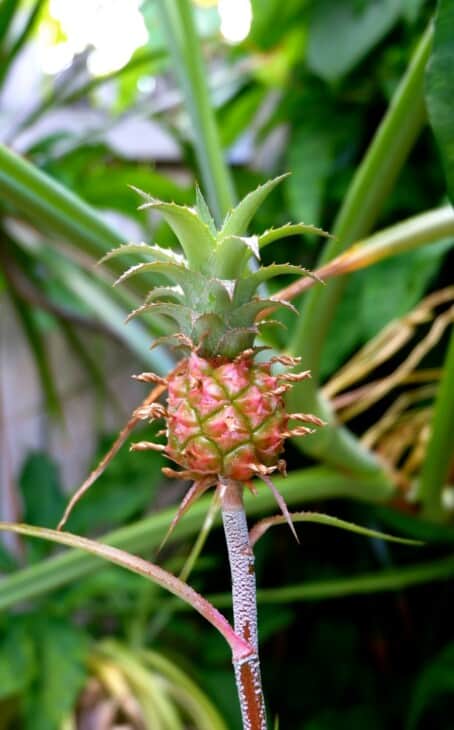
Dwarf pineapples (Ananas comosus var. microstachys) technically do produce a pineapple fruit, but these are ornamental. Dwarf pineapple plants show the characteristic pineapple form, but the plant size is smaller, making it ideal for filling in spaces in the garden or as an exotic addition indoors.
The plant will only produce fruit after about two years of growth. The miniature pineapple makes an ideal addition to an arrangement if cut from the mother plant. While technically edible, it is very acidic in taste and rather fibrous. Once the pineapple has set fruit, it will produce more baby plants called suckers. The top of the pineapple can also be planted to produce a new plant.
Not only do mini pineapples look good, but they will also clean the air indoors with great efficiency. Pineapple plants are adapted to fix carbon dioxide during the evenings, then store it in a processed form in the plant. The byproduct is released during the day as part of the photosynthesis process. Because of this feature, pineapple plants are fantastic air purifiers.
6. Cordyline
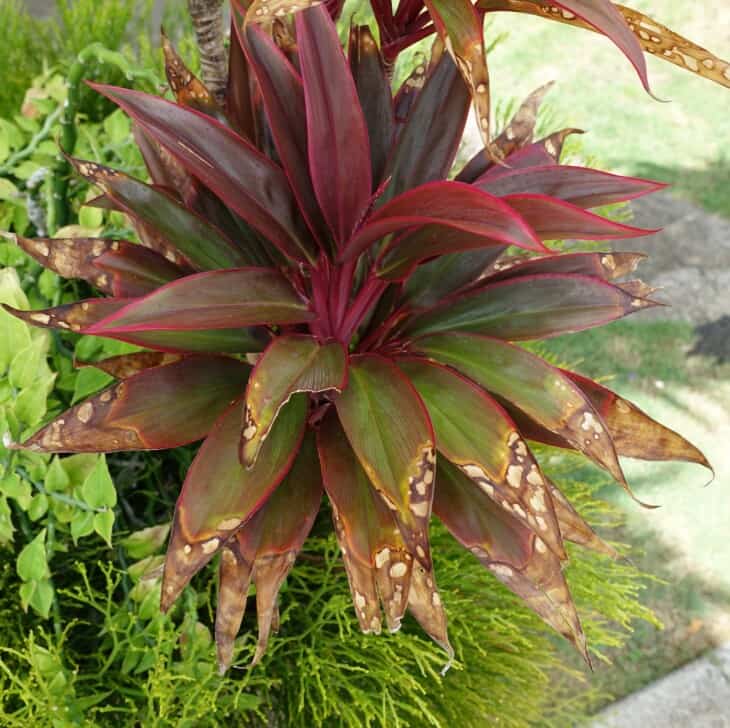
Cordyline, a member of the Asparagaceae family of plants, has roughly fifteen species. These plants are native to the Pacific Ocean region, where cordylines grow into trees as tall as fifteen feet. When cordyline is grown in cooler areas, they grow as shrubs, and a large number of these are ideal to even grow indoors.
Cordyline varieties differ greatly in appearance and size, but the leaves are very similar in appearance to that of a pineapple plant. Cordyline leaves are oblong and lance-shaped and can grow up to 20 inches long. They range in color from solid green to variegated varieties with red, burgundy, pink, or cream combinations like the Electric pink cordyline.
Cordyline plants are hardy and add texture and color to a garden or will brighten up an indoor space. Cordylines keep producing leaves upward and will lose older leaves on the lower stem as it grows. Any damage to the stem usually results in the plant producing a new side branch.
7. Air Plants
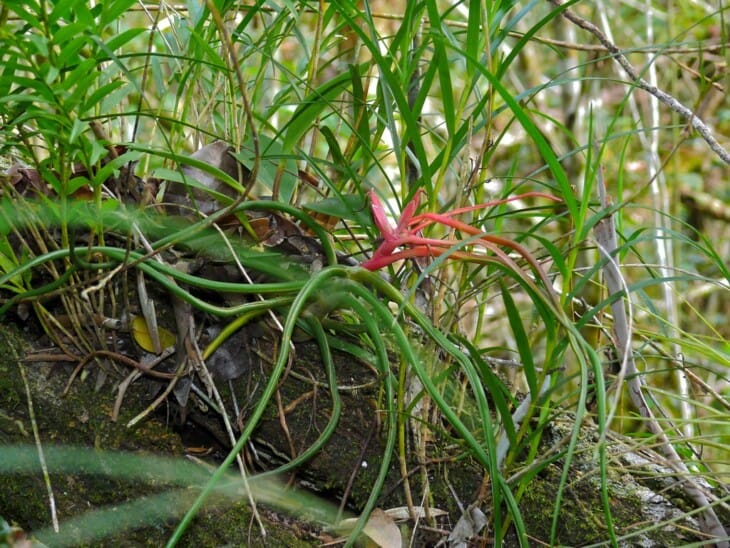
Like the pineapple, air plants in the Tillandsia genus are part of the Bromeliaceae family. With more than six hundred species in this family, there are a large number of varieties to choose from. Tillandsia air plants are native to forested areas ranging from the Caribbean and Argentina to Mexico.
Air plants are so named because they do not grow in soil. They attach themselves to trees, rocks, or even poles and use specialized cells on the leaves to collect water from the air. These cells give the spinney pineapple-shaped leaves a silver-grey color.
Air plants are ideal as indoor plants, and while they do like a good soaking in water from time to time, they should be allowed to dry out completely before the next watering. Air plants grow for many years before flowering, but once they have flowered, the plant produces an offset or pup and starts to die back.
Related: 11 Incredible Air Plant Benefits (Tillandsia)
8. Yucca Plants
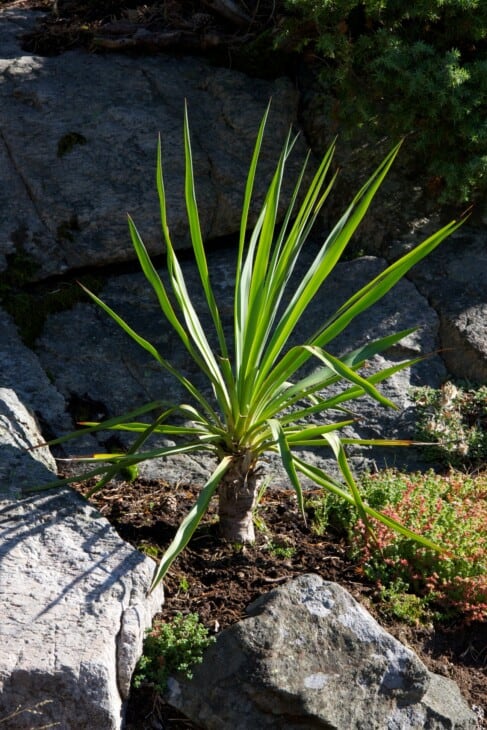
Yucca plants are perennials in the Asparagaceae plant family and go by names like Spanish dagger or Spanish bayonet. There are about fifty species of yucca, and these plants are highly adaptable. Yucca can grow in environments ranging from deserts to tropical regions.
Related: 8 Plants That Look Like Yucca
Smaller varieties like Caribbean yucca grow between two and four feet tall and are suited for indoor use or in small gardens, while varieties like the Joshua tree can reach up to thirty feet. There really is a variety to suit almost every space. What most yucca plants have in common is the sharp-tipped spikey leaves that grow from a central base, similar to a pineapple.
Most yucca plants produce large clusters of bell-shaped flowers, many of which are edible. The yucca flowers have a special mutualistic relationship with yucca moths. The moths pollinate the yucca flower, and the yucca plant protects the eggs the moth lays. Yucca plants have many uses ranging from sisal fiber extracted from the leaves as a food source (from fruit and flowers) and for medicinal use of the roots.

